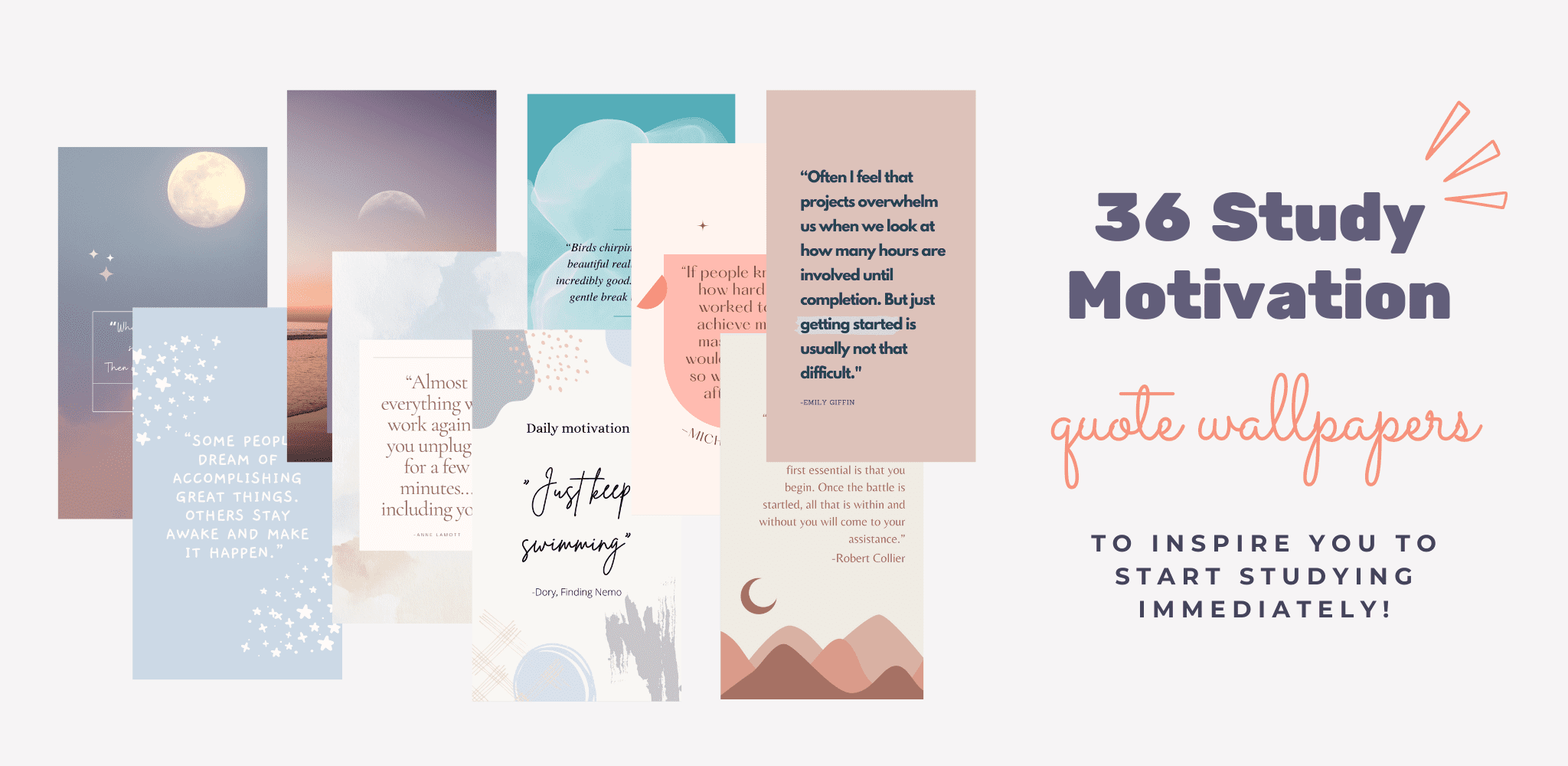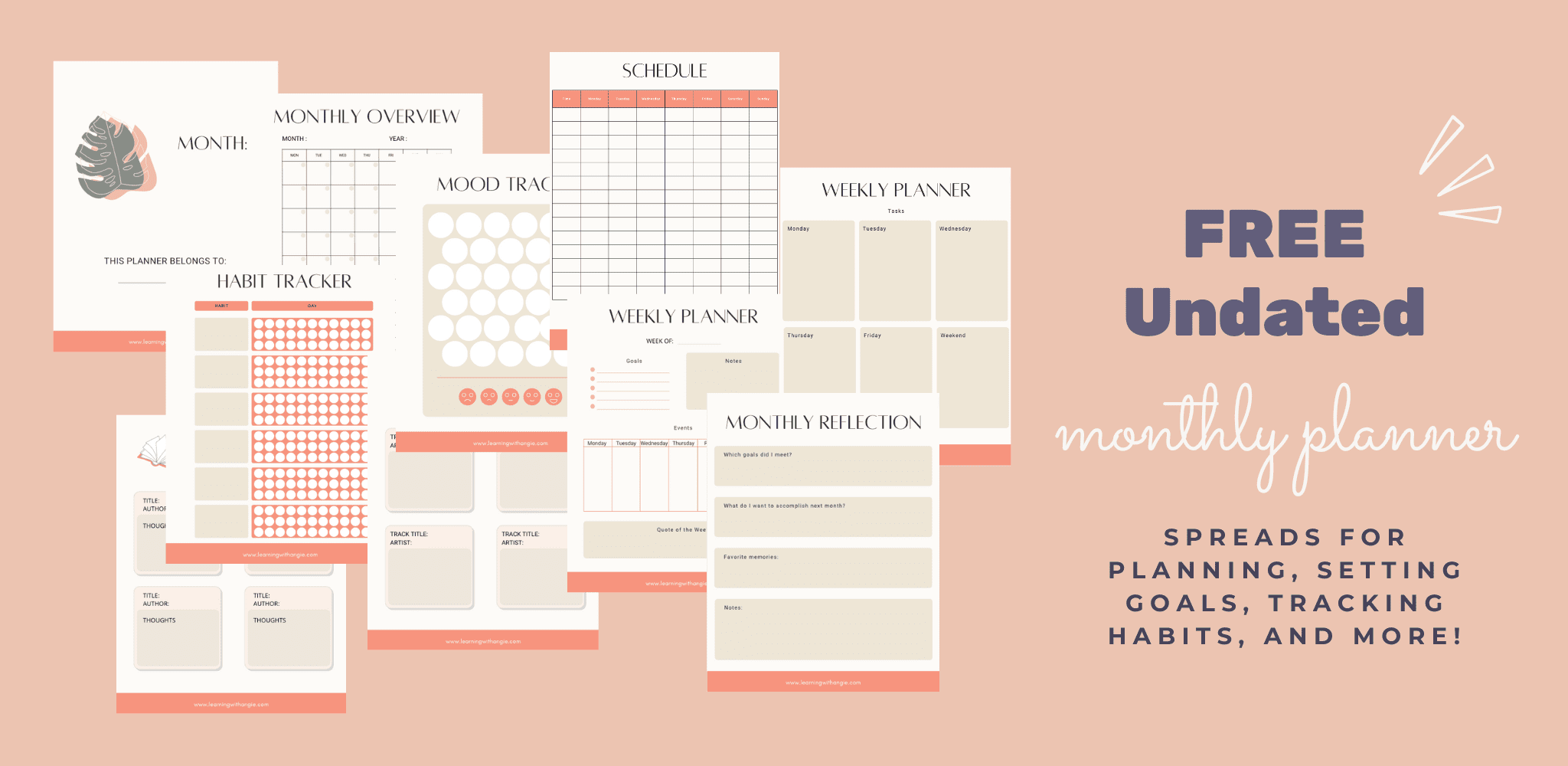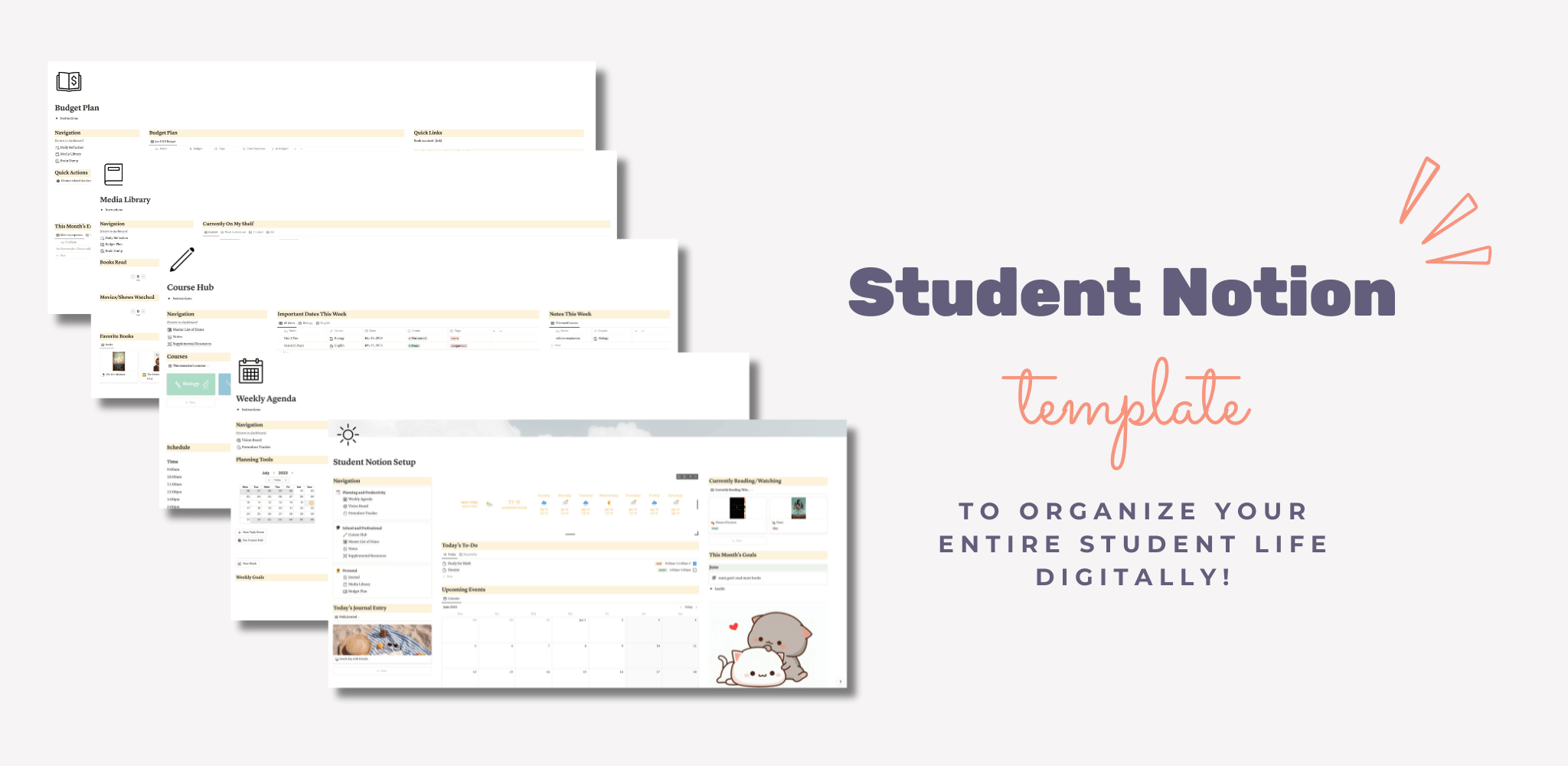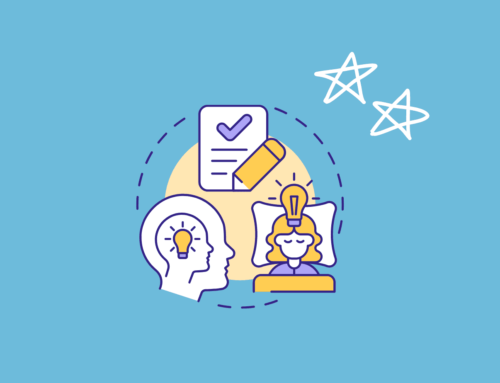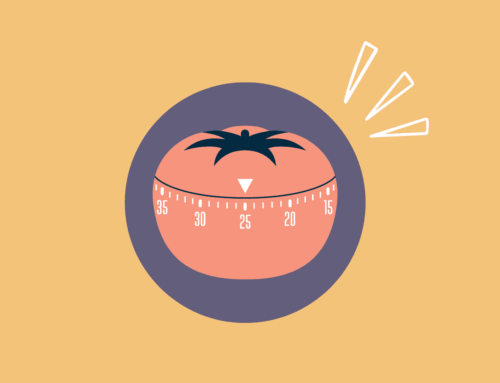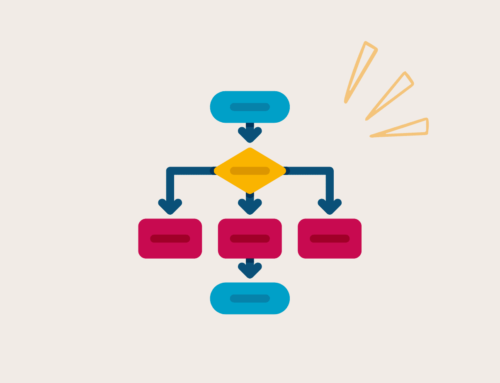
Here is a summary of the mind mapping method of note-taking (also known as concept mapping):
- Research shows that mind mapping can facilitate learning and metacognition (being aware of how well you understand something).
- The mind mapping method involves denoting a main topic at the center of the page, then branching out with related subtopics and supporting details. It provides a visual representation of the hierarchy of topics and their relationships to one another.
If you often get lost in the details and fail to see overarching connections, the mind mapping method can help you out.
In this post, I’ll be covering:
- What the mind mapping method is
- What makes the method effective
- Pros and cons of the method
- How to use the mind mapping method in 6 simple steps
- How to effectively study concept maps
Let’s dive in!
What is the Mind Mapping Method of Note-Taking?
The mind mapping method of note-taking involves denoting a main topic at the center of the page, then branching out with related subtopics and supporting details.
Mind maps make it easy to see how concepts are related to one another. This helps you become aware of overarching connections and ideas in a sea of otherwise disconnected details.
You can also add drawings to mind maps to make them more visually appealing. Plus, drawings can supplement your learning!
How is Mind Mapping Different from Regular Note-Taking and Studying?
Unlike other common note-taking methods (like the sentence method, outline method, or Cornell method), mind mapping is not a linear note-taking method. In linear note-taking, you write down information as you hear or read it.
In mind mapping, however, you’re focused on identifying relationships between topics you’ve already learned. Therefore, it’s not a good note-taking method to use when learning something for the first time.
Instead, you should use it to supplement your understanding and retention of information during review sessions.
This leads me to the next section…
When to Use the Mind Mapping Method
As I mentioned, the mind mapping method is best suited for review—it isn’t applicable to situations where you’re learning something for the first time.
The mind mapping method is especially helpful for understanding content in which it’s easy to get lost in the details. This includes (but is not limited to) subjects like:
- History is filled with tons of events, people, places, and other details. Creating a concept or mind map can help you see how details are related to one another, allowing overarching themes and trends to emerge.
- Biology has a lot of interconnected, complex systems that can be better understood with a mind map.
You may also like “14 Effective & Efficient Note-Taking Methods”
Why is Mind Mapping Helpful and Effective for Students to Use?
Mind Mapping Facilitates Learning and Retention
In one study, researchers found that students enrolled in a cardiovascular care therapeutics course benefited from making mind maps. Students who made mind maps had higher test scores and a better understanding of the material.
In another study, researchers reviewed studies on the efficacy of mind mapping in students from 4th grade to postsecondary in several subject areas. They found a positive correlation between using mind maps and knowledge retention.
Clearly, the results from various studies show that using the mind mapping method is associated with better learning and retention.
Mind Mapping Promotes Metacognition
Metacognition is the awareness of how you think. In regards to learning and studying, it refers to your awareness of how well you understand a topic. Contrary to intuition, we’re not very good at assessing our level of understanding.
However, mind mapping can help you out!
In one study, researchers put 4th-grade students in 3 groups. One group made mind maps, another was given pre-made mind maps, and the final group read the material twice (they did not use mind maps).
Students were asked to predict how well they expected to do on a test. Researchers found that students in the first group predicted their test performance most accurately.
This leads to the conclusion that making mind maps can help you identify what you understand and what you don’t. You can then focus on reviewing material you don’t understand well yet.
Mind Mapping Method Advantages and Disadvantages
Every method of note-taking comes with various advantages and disadvantages. Make sure to consider these when deciding whether to use the mapping method of note-taking.
Advantages
- You will recognize connections between topics, rather than getting lost in the details.
- You can study using a visual representation of topics.
- You can better assess your level of understanding (metacognition).
- You can easily modify a mind map by adding additional branches or lines connecting topics.
- You can make a digital mind map.
You may also like “7 Secret Tips For Studying That Will Transform How You Study”
Disadvantages
- A mind map can get messy.
- You can’t use the mapping method during a live lecture or for learning new content. That’s because you need to know the content before identifying connections within it.
- You will most likely need to supplement a mind map with other notes, such as those taken during a live lecture or when reading from a textbook.
How to Use the Mind Mapping Method in 6 Steps
Step #1: Get Your Note-Taking Materials
If you’re making a handwritten mind map, grab the following:
- Pen
- Paper
- Colored pens or colored pencils (for color coding and drawing)
If you’re making a digital mind map, select a digital platform. In my example, I chose to make my mind map using Canva. There are other options that may be easier to use but are limited in the number of free projects. These include Bubble.us, MindMeister, and MindMup.
Step #2: Identify the Main Topic
Identify the central topic and put it in a circle at the center of the page. This is the umbrella topic that everything else should be related to.
As you can see, the main topic of my mind map is “Native American Settlements Pre-European Arrival”.

Step #3: Add Subtopics
Write down subtopics around the main topic. Then, connect them to the main topic with lines (or arrows, as I’ve done).
In my mind map, I decided to choose the subtopics based on the geographic location of Native American settlements (except for “large, high-organized empires”). They are:
- American Northwest and East Coast
- Large, highly-organized empires
- Great Plains
- American Northwest and Present-Day California
As you can see, I decided to assign a different color to each subtopic. You can do the same to more easily distinguish between subtopics and their supporting details.

Step #4: Add Supporting Details
Write down supporting details and add lines connecting them to the corresponding subtopic. If you chose a color key in the previous step, make sure to stick with it.
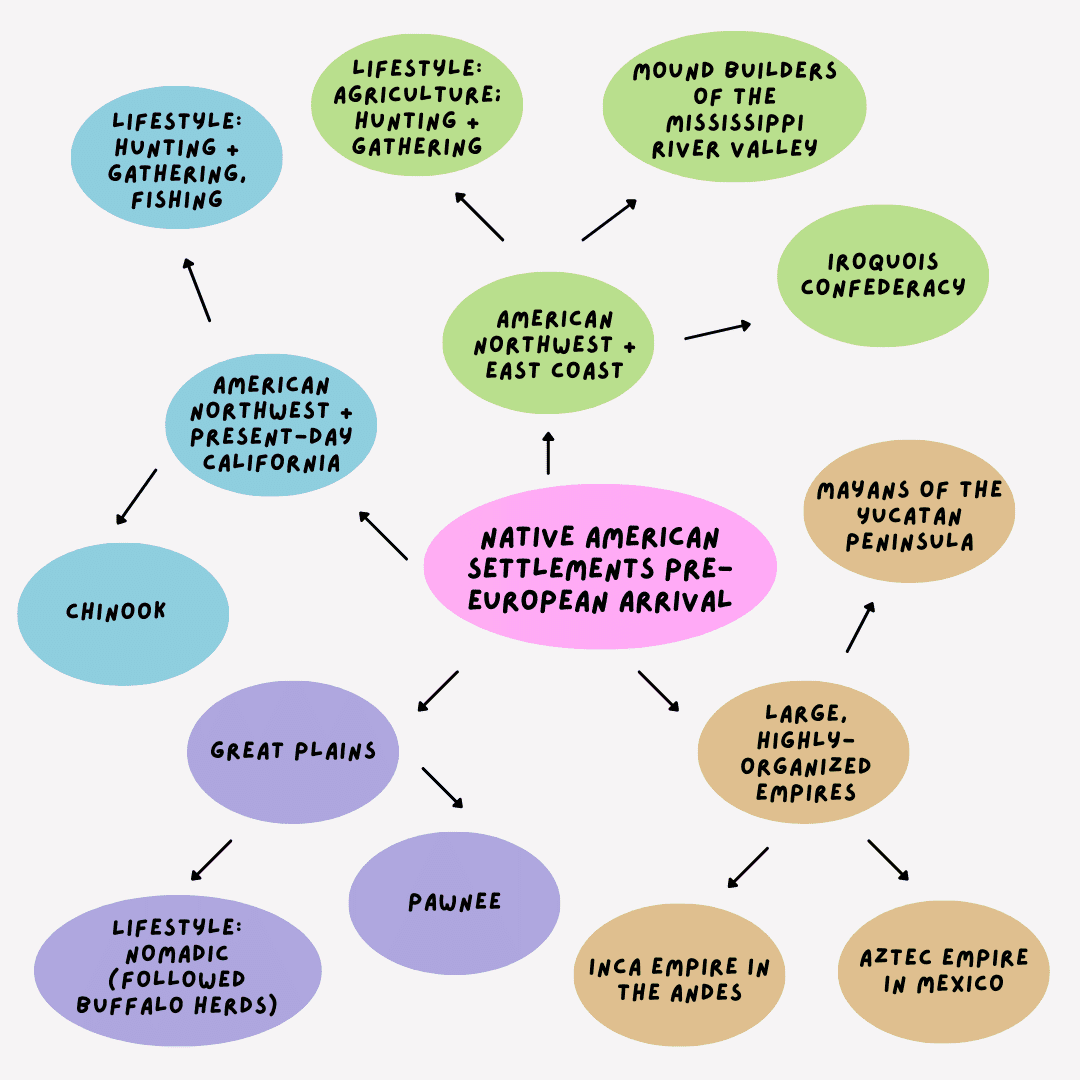
Step #5: Keep Branching Out and/or Add Pictures
At this point, you can keep branching out from the supporting details by adding more information and connecting lines. (In my example, I didn’t do this.)
Or, you can choose to add pictures. One research study showed that drawing results in better retention than writing. Even if you don’t draw the pictures yourself, viewing images can still boost your retention and learning.
If you’re handwriting your mind map, you can draw quick doodles or print online images. If you’re making a digital mind map, adding visuals is even simpler.
You may also like “7-Day Dopamine Detox for Studying—Skyrocket Your Focus Now!”
Step #6: Review Your Mind Map
Do you ever feel like you can hardly recall a lecture you just sat in? This isn’t surprising due to a phenomenon known as the Ebbinghaus Forgetting Curve.
According to the Forgetting Curve, we forget on average 90% of new concepts we learn after being exposed to them once. Therefore, you must review your notes—preferably within 24 hours of taking them.
However, there are effective and not-so-effective ways to review your notes. That leads me to the next section…
How to Study a Mind Map
Use Active Recall
Active recall is an effective studying strategy that should be part of every student’s routine. Instead of relying on an external source (like your notes or a textbook), active recall requires you to pull information from your existing knowledge base.
Skimming through your mind map doesn’t count as active recall. Instead, you should challenge yourself by only reading the subtopics. Try to recall as much as you can before looking at the connecting details.
Employ Critical Thinking
Although making a mind map already requires critical thinking, you should continue to employ critical thinking when reviewing your map.
Try to recognize new connections between topics. Or, brainstorm real-world examples of topics and think about how the topics relate to prior knowledge.
Supplement Your Review Sessions With Other Notes
A mind map on its own might not be a comprehensive review of information. If so, make sure to supplement your review sessions with other notes you may have taken (such as during live lectures or while reading a textbook).
Use Spaced Repetition
Reviewing your notes within 24 hours of taking them will help you remember them better… but not indefinitely.
To combat the Forgetting Curve, you need to use spaced repetition. This involves reviewing your notes in periodic intervals. Luckily, after each review session, you can wait longer until your next review session.
Since it can be difficult to keep track of spaced repetition dates, I use Notion to automate my study schedule. (Notion is an all-in-one workspace that I use as a student planner app and note-taking app.)

You may also like “Best Aesthetic Note Taking App (Free & Easy-to-Use)”
FAQ
How is mind mapping different from Cornell note-taking?
The Cornell note-taking method is a linear note-taking method that can be used when hearing or reading information for the first time. It involves splitting your page into two columns: a narrow left column for keywords and a wider right column for descriptions and examples. You also need to leave room at the bottom of each page for a brief summary.
When learning information for the first time, you record your notes in the right column. After, you add keywords to the left column and fill in the summary sections.

The mapping method of note-taking is NOT linear. Also, you need to know the content before making a mind map. After all, if you don’t know the content, how can you identify relationships within the content?
You should therefore use the mapping method as a supplement for notes you’ve already taken. Creating a concept map can help you understand and retain information in a visual format. However, it should not be a substitute for more traditional methods of note-taking, like the Cornell method or outline method.
What learning style is mind mapping?
Mind mapping draws on a visual learning format. If you use color coding and add pictures, you can reinforce the visual learning benefits of creating a concept map.
What are the advantages of the mapping method?
The mapping method makes it easy to recognize the connections between topics.
Research has also shown that it promotes metacognition, which is your awareness of how well you understand something. This awareness can help you identify what you need to focus on when studying.
Also, you can revise mind maps easily. If you recognize new connections or related ideas in future review sessions, you can add them to your map.
Overview of the Mapping Method of Note-Taking
Mind maps provide a visual representation of relationships between concepts. While you shouldn’t use the mapping method when learning information for the first time, it can reinforce your learning in subsequent review sessions.
That’s because mapping compels you to recognize the overarching connections—you won’t be so focused on individual trees that you miss the forest.
The mapping method consists of 6 simple steps:
- Prepare your note-taking materials
- Add the main topic at the center
- Add subtopics branching out from the main topic
- Add supporting details branching out from the subtopics
- Add more branches as needed, and consider adding pictures
- Review your map using active recall and supplemental materials
I hope this post showed you how to use the mapping method of note-taking effectively!
For more on note-taking, check out these posts:
For more posts on studying and note-taking, check out:
- 7-Day Dopamine Detox for Studying—Skyrocket Your Focus Now!
- Best Aesthetic Note Taking App (Free & Easy-to-Use)
- How to Apply Atomic Habits to Studying to Get Better Grades
- How to Wake Up at 5am to Study—Tips From a Former Night Owl
- 5 Ways to Increase Attention Span While Studying Immediately
- 7 Secret Tips For Studying That Will Transform How You Study
Will you be using the mapping method of note-taking? If so, in which subjects do you intend to implement it? Let me know in the comments below!

Learning With Angie is a place to share honest, unfiltered advice to promote student success. So if you’re a student (high school, college, or beyond) looking for tips on productivity, studying, personal growth, and more to reach your potential, this is the place! To read more about Learning with Angie, click here.

